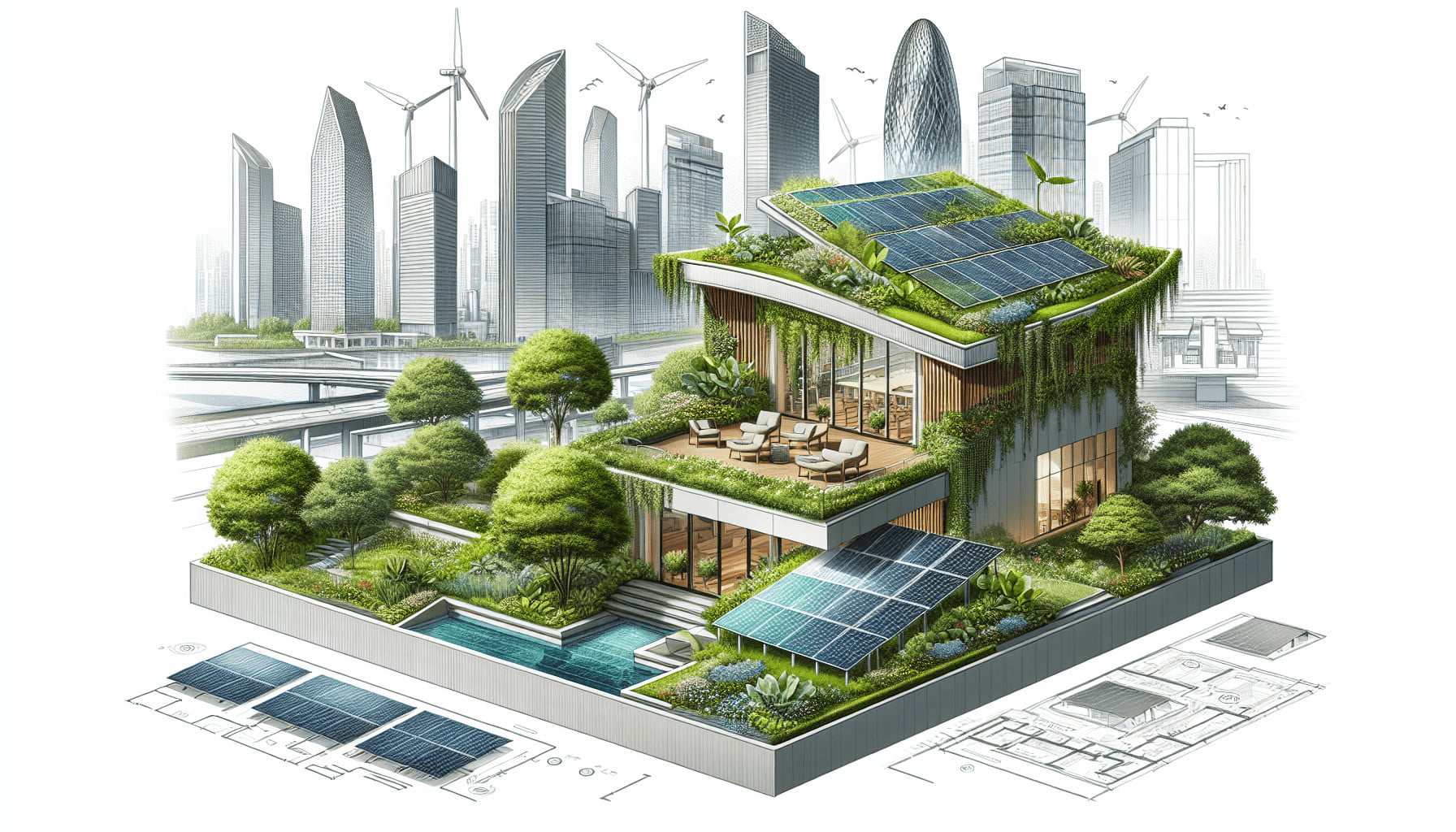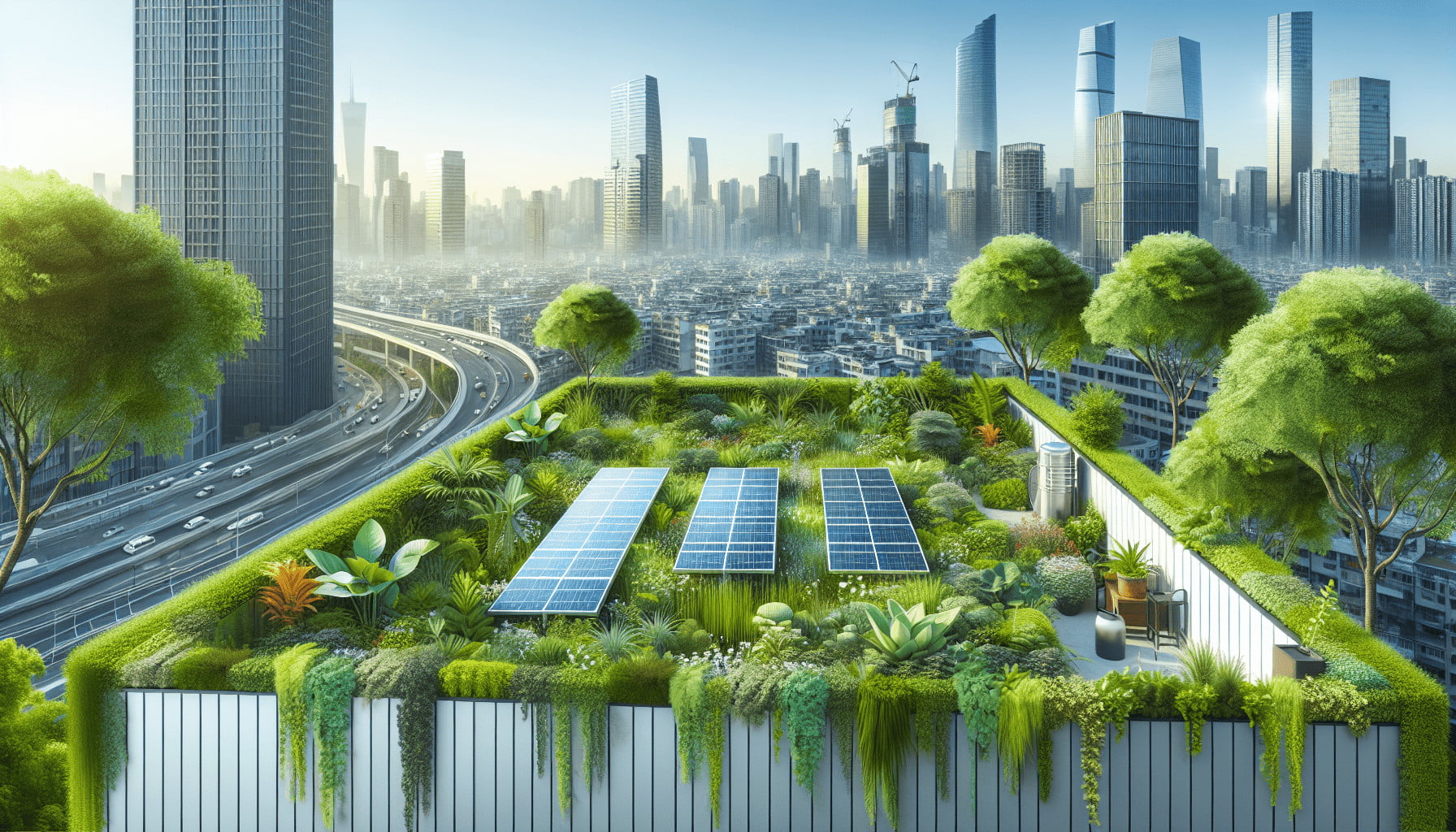Have you ever wondered how you can make a building not only environmentally friendly but also highly energy-efficient? Integrating green roof systems with renewable energy technologies is a cutting-edge approach to achieving this. The synergy between green roofs and renewable energy sources, like solar panels and wind turbines, creates a holistic solution that benefits both the environment and your bottom line.
Understanding Green Roof Systems
Green roofs, also known as vegetative or eco-roofs, consist of a layered system that supports the growth of plants on top of a building. These systems include various layers: vegetation, growing medium, filter sheet, drainage layer, root barrier, and waterproofing membrane.
Types of Green Roofs
Before delving into their integration with renewable energies, it’s essential to understand the two main types of green roofs:
- Intensive Green Roofs: These roofs are akin to traditional gardens. They support large plants, including shrubs and small trees, due to their deep growing medium. Intensive roofs require more maintenance and stronger structural support.
- Extensive Green Roofs: These are much lighter and typically host small plants, such as sedum and grasses, requiring minimal maintenance. They are more suitable for buildings not designed to hold heavy loads.
Here’s a quick comparison:
| Feature | Intensive Green Roofs | Extensive Green Roofs |
|---|---|---|
| Plant Types | Shrubs, Trees, Perennials | Sedums, Grasses, Mosses |
| Growing Medium Depth | 6-12 inches or more | 1-6 inches |
| Maintenance | High | Low |
| Structural Requirement | High | Low to Moderate |
Benefits of Green Roof Systems
Green roofs offer a multitude of benefits including energy savings, stormwater management, reducing urban heat island effect, and improving air quality. Let’s break these down:
Energy Savings
Green roofs provide insulation, reducing the need for heating in the winter and air conditioning in the summer. This helps lower energy bills and decreases the building’s carbon footprint.
Stormwater Management
Vegetative roofs absorb substantial amounts of rainwater, reducing runoff and the risk of flooding. This water is then used by the plants or slowly released back into the atmosphere through evaporation and transpiration.
Reducing Urban Heat Island Effect
By adding greenery to urban areas, green roofs help to cool the surrounding environment. Plants absorb sunlight and use it for photosynthesis rather than converting it into heat, as traditional roofs do.
Improving Air Quality
Plants on green roofs capture airborne pollutants and filter noxious gases. This improves the air quality around the building, benefiting both people and wildlife.

Renewable Energy Technologies
Integrating renewable energy technologies with green roofs involves the use of solar panels, wind turbines, and other sustainable energy sources to generate power. These technologies harness natural resources, reducing dependency on fossil fuels and minimizing environmental impact.
Solar Panels
Solar panels convert sunlight into electricity using photovoltaic cells. They are one of the most common and effective renewable energy sources.
Types of Solar Panels
- Monocrystalline Solar Panels: High efficiency and long lifespan but more expensive.
- Polycrystalline Solar Panels: Less efficient than monocrystalline but more affordable.
- Thin-Film Solar Panels: Flexible, lightweight, and can be installed on curved surfaces. Less efficient but versatile.
Wind Turbines
Wind turbines convert kinetic energy from the wind into mechanical power, which can then be converted into electricity. Small wind turbines can be installed on rooftops, providing a supplementary energy source.
Types of Wind Turbines
- Horizontal Axis Wind Turbines (HAWT): Common and efficient but require space and proper wind direction.
- Vertical Axis Wind Turbines (VAWT): Suitable for urban areas as they work well in turbulent wind conditions and are more compact.
Other Renewable Energy Sources
- Solar Thermal Systems: Use sunlight to heat water or air, providing a sustainable option for heating needs.
- Geothermal Systems: Utilize the earth’s natural heat to regulate building temperatures, offering a stable and consistent energy source.
The Synergy of Green Roofs and Renewable Energy
The combination of green roofs and renewable energy technologies creates a synergy that enhances the benefits of each system. Let’s explore how these systems work together.
Improved Efficiency of Solar Panels
Vegetative roofs keep the rooftop cooler, preventing solar panels from overheating. This increased efficiency results in more energy production and a longer lifespan for the solar panels.
Enhanced Performance of Wind Turbines
Plants and greenery reduce air turbulence around wind turbines, improving their performance. The stabilization of airflow supports more consistent energy generation.
Integrated Water Management
Green roofs can be designed to channel rainwater to a collection system, which can then be used for water cooling of solar panels or other building needs. This not only conserves water but also increases energy efficiency.
Aesthetics and Biodiversity
The combination of green roofs and renewable energy technology not only looks appealing but also supports urban biodiversity. Birds, insects, and other wildlife find habitats in green roofs, contributing to a healthier ecosystem.

Case Studies and Examples
Understanding theoretical advantages is one thing, but seeing real-world applications solidifies the concept. Let’s look at a few examples where green roofs and renewable energy technologies have successfully been integrated.
Example 1: Green Roofs and Solar Panels in Berlin, Germany
In Berlin, several buildings feature green roofs with integrated solar panels. These projects have shown that the synergy between the two systems results in increased energy production and significant reductions in urban heat island effects and stormwater runoff.
Example 2: The Academy of Sciences in San Francisco, USA
The California Academy of Sciences has a living roof and solar panels. The living roof includes native plants and provides habitat for local species, while the solar panels contribute to the museum’s energy needs. Together, they result in unique environmental and educational benefits.
Example 3: School Building in London, UK
A school in London incorporated a green roof with solar panels and wind turbines. The green roof supports a school garden project, while the renewable energy systems provide power and educational opportunities for students.
Challenges and Solutions
While integrating green roof systems with renewable energy technologies offers many advantages, it also presents several challenges. Addressing these challenges is crucial for successful implementation.
Structural Support
Green roofs add extra weight to buildings, and the addition of solar panels or wind turbines further increases this load. Ensuring your building can support this weight is essential.
Solution: Conduct a thorough structural analysis and work with engineers to retrofit the building if necessary. Lightweight green roof systems and appropriate structural reinforcements can mitigate this issue.
Initial Costs
Both green roofs and renewable energy systems require substantial upfront investments.
Solution: Consider long-term savings and benefits. Financial incentives, rebates, and grants are often available for sustainable projects, which can help offset initial costs.
Maintenance
Both systems require periodic maintenance to ensure optimal performance.
Solution: Develop a comprehensive maintenance plan. For green roofs, this includes irrigation, plant care, and monitoring for any leaks. Renewable energy systems require regular inspections, cleaning, and performance checks.
Integration Complexity
Combining two advanced systems can be complex and may require specialized knowledge.
Solution: Collaborate with experts in both fields for design, installation, and maintenance. Using a holistic design approach from the outset simplifies integration.
Environmental and Economic Impact
The integration of green roofs and renewable energy systems has far-reaching impacts on both the environment and economy.
Environmental Benefits
- Reduced Carbon Footprint: The combination of these systems significantly cuts down greenhouse gas emissions.
- Improved Urban Biodiversity: Green roofs provide habitats, increasing urban biodiversity.
- Climate Resilience: These systems help mitigate the impacts of climate change by reducing heat flux and managing stormwater.
Economic Benefits
- Energy Savings: Reduced energy bills lead to long-term financial savings.
- Increased Property Value: Sustainable features can increase a building’s market value.
- Job Creation: Installing and maintaining these systems creates green jobs in engineering, construction, and landscaping.
Future Trends and Innovations
As we look ahead, several trends and innovations are likely to shape the future of integrating green roof systems with renewable energy technologies.
Modular Green Roof and Solar Panel Systems
Developing modular systems for both green roofs and solar panels can simplify installation and maintenance. These modules can be pre-grown and pre-fitted with panels, then easily installed on site.
Smart Technology Integration
Applying Internet of Things (IoT) technology to these systems can enhance performance. Sensors can monitor plant health, water usage, and energy production, providing real-time data to optimize operations.
New Materials and Plant Varieties
Innovations in materials and plant varieties can increase the effectiveness and longevity of green roofs. For example, drought-resistant plants and lightweight growing mediums reduce maintenance and structural demands.
Policy and Incentives
Government policies and incentives play a crucial role in the adoption of these technologies. Future trends may include more robust policies that mandate or incentivize green roofs and renewable energy systems for new developments.
Conclusion
Integrating green roof systems with renewable energy technologies offers a promising solution to many urban environmental challenges. These systems not only provide substantial environmental benefits, including improved air quality, reduced urban heat islands, and enhanced energy efficiency but also offer economic advantages such as increased property value and energy savings.
The synergy between green roofs and renewable energy systems creates a holistic approach that maximizes the benefits of each technology. Challenges such as structural support, initial costs, and maintenance can be effectively managed through thoughtful planning and collaboration with experts.
As we look to the future, innovations in modular systems, smart technology, materials, and policy support will further simplify and promote the adoption of these integrated systems. By embracing this sustainable approach, you can contribute to a greener, more resilient urban environment while also realizing economic benefits.
So, the next time you think about making your building more sustainable, consider the powerful combination of green roofs and renewable energy technologies. The future of urban living is green, energy-efficient, and within your reach.
